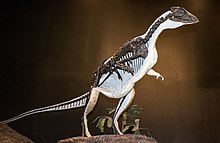Oryctodromeus
| Oryctodromeus Temporal range: Late Cretaceous,
| |
|---|---|

| |
| Reconstructed skeleton, Museum of the Rockies | |
| Scientific classification | |
| Domain: | Eukaryota |
| Kingdom: | Animalia |
| Phylum: | Chordata |
| Clade: | Dinosauria |
| Clade: | †Ornithischia |
| Family: | †Thescelosauridae |
| Subfamily: | †Orodrominae |
| Genus: | †Oryctodromeus Varricchio et al., 2007 |
| Type species | |
| †Oryctodromeus cubicularis Varricchio et al., 2007
| |
Oryctodromeus (meaning "digging runner") was a
Description

Oryctodromeus was originally described as lacking ossified tendons in the tail. However, specimens from the Wayan Formation demonstrate the presence of a thick tendon lattice in the dorsal, sacral, and caudal columns of some specimens; perhaps indicating more flexibility in ossified tendons than has previously been supposed.[1] Adaptations in the jaws, forelimbs, and pelvis were described in the Blackleaf specimens that could have helped move and manipulate soil.[2]
The authors pointed out that Oryctodromeus had only modest forelimb modifications in comparison to dedicated burrowing animals, like moles, echidnas, and wombats. Instead, it was comparable to, but somewhat more specialized for digging than animals that both run and burrow today, like aardwolves, cavies, hyenas, and rabbits. Because it was a biped, it could have a more modified forelimb without affecting its ability to run.[2]
Discovery

Oryctodromeus is
Classification

Under a
but this has yet to be published.Paleobiology
As a basal ornithopod, Oryctodromeus would have been a small, swift herbivore. This aspect, coupled with where it was discovered, gives it its name: Oryctodromeus cubicularis translates as "digging runner of the lair", in reference to its presumed lifestyle. The adult Oryctodromeus itself measured 2.1 m (6.9 ft) long and would have weighed about 22-32 kilograms (50-70 pounds), and the juveniles would have been about 1.3 m (4.3 ft) long. The presence of juveniles with the adult suggests parental care, and that at least one motivation for burrowing was to rear the juveniles. The size of the juveniles suggests an extended period of parental care.[2]
Burrowing behavior

The three Oryctodromeus individuals were found buried within the remains of an underground den or
There are two turns in the preserved burrow section, and smaller secondary sandstone cylinders of various sizes (a few centimeters or inches in cross-section at most) that were probably made by smaller animals sharing the burrow (commensal). The burrow closely fits the probable proportions of the adult dinosaur, another indication that it was the digger.[4][5][6]
References
- ^ a b Krumenacker, L. J., 2010. Chronostratigraphy and paleontology of the mid-Cretaceous Wayan Formation of eastern Idaho, with a description of the first Oryctodromeus specimens from Idaho. BYU MS thesis."
- ^ PMID 17374596.
- ^ Buchholz, Peter (1998-03-16). "Drinker and burrowing". Retrieved 2007-03-22.
- ^ Hecht, Jeff; Jeff Hecht (2007-03-21). "Dinosaur digger found in its own burrow". News Service. New Scientist.com. Retrieved 2007-03-23.
- ^ Owen, James; James Owen (2007-03-21). "Digging Dinosaur Discovered Inside Fossil Den". National Geographic News. National Geographic. Archived from the original on March 27, 2007. Retrieved 2007-03-23.
- ^ "Asteroid may have forced dinosaur to dig". Science & Nature. The Australian: Keeping the Nation Informed. 2007-03-22. Archived from the original on 2007-03-29. Retrieved 2007-03-23.
